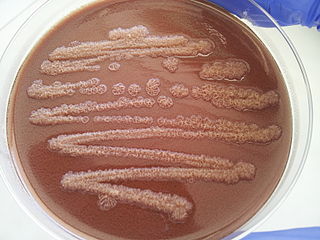
Pseudomonas is a genus of Gram-negative bacteria belonging to the family Pseudomonadaceae in the class Gammaproteobacteria. The 313 members of the genus demonstrate a great deal of metabolic diversity and consequently are able to colonize a wide range of niches. Their ease of culture in vitro and availability of an increasing number of Pseudomonas strain genome sequences has made the genus an excellent focus for scientific research; the best studied species include P. aeruginosa in its role as an opportunistic human pathogen, the plant pathogen P. syringae, the soil bacterium P. putida, and the plant growth-promoting P. fluorescens, P. lini, P. migulae, and P. graminis.

Pseudomonas putida is a Gram-negative, rod-shaped, saprophytic soil bacterium. It has a versatile metabolism and is amenable to genetic manipulation, making it a common organism used in research, bioremediation, and synthesis of chemicals and other compounds.
Pseudomonas alcaligenes is a Gram-negative aerobic bacterium used for bioremediation purposes of oil pollution, pesticide substances, and certain chemical substances, as it can degrade polycyclic aromatic hydrocarbons. It can be a human pathogen, but occurrences are very rare. Based on 16S rRNA analysis, P. alcaligenes has been placed in the P. aeruginosa group.
Pseudomonas chlororaphis is a bacterium used as a soil inoculant in agriculture and horticulture. It can act as a biocontrol agent against certain fungal plant pathogens via production of phenazine-type antibiotics. Based on 16S rRNA analysis, similar species have been placed in its group.
Mycobacteroides chelonae is a species of bacteria from the phylum Actinomycetota belonging to the genus Mycobacteroides. Mycobacteroides chelonae is a rapidly growing mycobacterium that is found all throughout the environment, including sewage and tap water. It can occasionally cause opportunistic infections of humans. It is grouped in Runyon group IV.
Mycobacteroides immunogenum is a species of bacteria from the phylum Actinomycetota, belonging to the genus Mycobacteroides.
Pseudomonas agarici is a Gram-negative soil bacterium that causes drippy gill in mushrooms. It was first isolated in New Zealand. P. agarici could not be grouped based on 16S rRNA analysis, so it is designated incertae sedis in the genus Pseudomonas.
Pseudomonas citronellolis is a Gram-negative, bacillus bacterium that is used to study the mechanisms of pyruvate carboxylase. It was first isolated from forest soil, under pine trees, in northern Virginia, United States.
Pseudomonas mendocina is a Gram-negative environmental bacterium that can cause opportunistic infections, such as infective endocarditis and spondylodiscitis, although cases are very rare. It has potential use in bioremediation as it is able to degrade toluene. Based on 16S rRNA analysis, P. mendocina has been placed in the P. aeruginosa group.
Pseudomonas libanensis is a Gram-negative, rod-shaped, fluorescent, motile bacterium isolated from natural springs in Lebanon. Based on 16S rRNA analysis, P. libanensis has been placed in the P. fluorescens group.
Pseudomonas veronii is a Gram-negative, rod-shaped, fluorescent, motile bacterium isolated from natural springs in France. It may be used for bioremediation of contaminated soils, as it has been shown to degrade a variety of simple aromatic organic compounds. Based on 16S rRNA analysis, P. veronii has been placed in the P. fluorescens group.
Pseudomonas synxantha is a fluorescent rhizosphere bacterium with nematicidal properties. Based on 16S rRNA analysis, P. synxantha has been placed in the P. fluorescens group.
Pseudomonas straminea is a Gram-negative, rod bacterium that includes strains formerly identified as P. ochracea. Based on 16S rRNA analysis, P. straminea has been placed in the P. aeruginosa group.
Pseudomonas plecoglossicida is a non-fluorescent, Gram-negative, rod-shaped, motile bacterium that causes hemorrhagic ascites in the ayu fish, from which it derives its name. Based on 16S rRNA analysis, P. plecoglossicida has been placed in the P. putida group.
Pseudomonas cedrina is a Gram-negative, rod-shaped bacterium isolated from spring waters in Lebanon. Based on 16S rRNA analysis, P. cedrina has been placed in the P. fluorescens group.
Pseudomonas mandelii is a fluorescent, Gram-negative, rod-shaped bacterium isolated from natural spring waters in France. Based on 16S rRNA analysis, P. mandelii has been placed in the P. fluorescens group.

Pseudomonas stutzeri is a Gram-negative soil bacterium that is motile, has a single polar flagellum, and is classified as bacillus, or rod-shaped. While this bacterium was first isolated from human spinal fluid, it has since been found in many different environments due to its various characteristics and metabolic capabilities. P. stutzeri is an opportunistic pathogen in clinical settings, although infections are rare. Based on 16S rRNA analysis, this bacterium has been placed in the P. stutzeri group, to which it lends its name.
Pseudomonas resinovorans is a Gram-negative, soil bacterium that is commonly found in the lubricating oils of wood mills. It is able to degrade carbazole, and as such, may be used in bioremediation. Based on 16S rRNA analysis, P. resinovorans has been placed in the P. aeruginosa group.
Streptococcus gordonii is a Gram-positive bacterium included among some of the initial colonizers of the periodontal environment. The organism, along with related oral streptococci, has a high affinity for molecules in the salivary pellicle on tooth surfaces. S. gordonii therefore can rapidly colonize clean tooth surfaces, and S. gordonii along with related organisms comprise a high percentage, up to 70%, of the bacterial biofilm that forms on clean tooth surfaces. Generally harmless in the mouth, S. gordonii can cause acute bacterial endocarditis upon gaining access systemically. S. gordonii also forms an attachment substratum for later colonizers of tooth surface and can modulate the pathogenicity of these secondary colonizers through interspecies communication mechanisms.
Ehrlichia muris is a species of pathogenic bacteria first isolated from mice, with type strain AS145T. Its genome has been sequenced.


